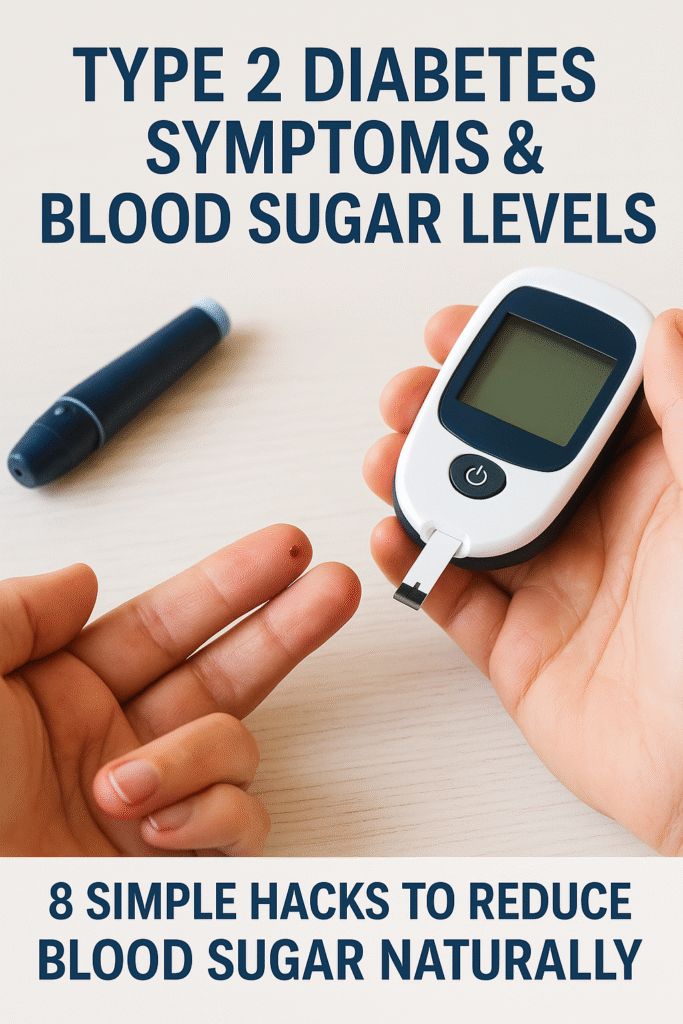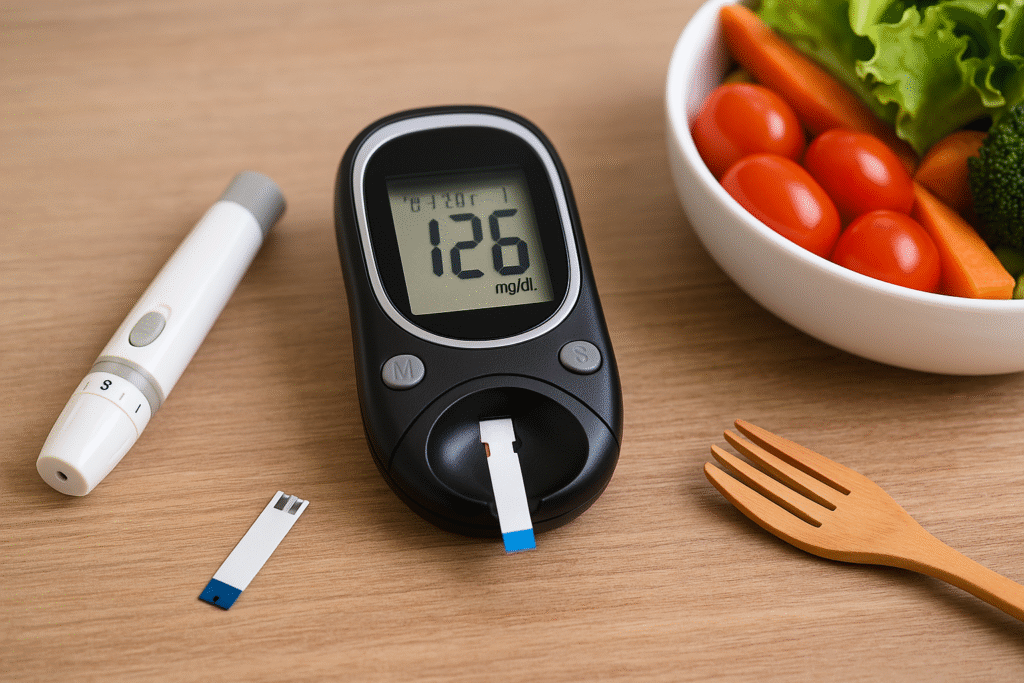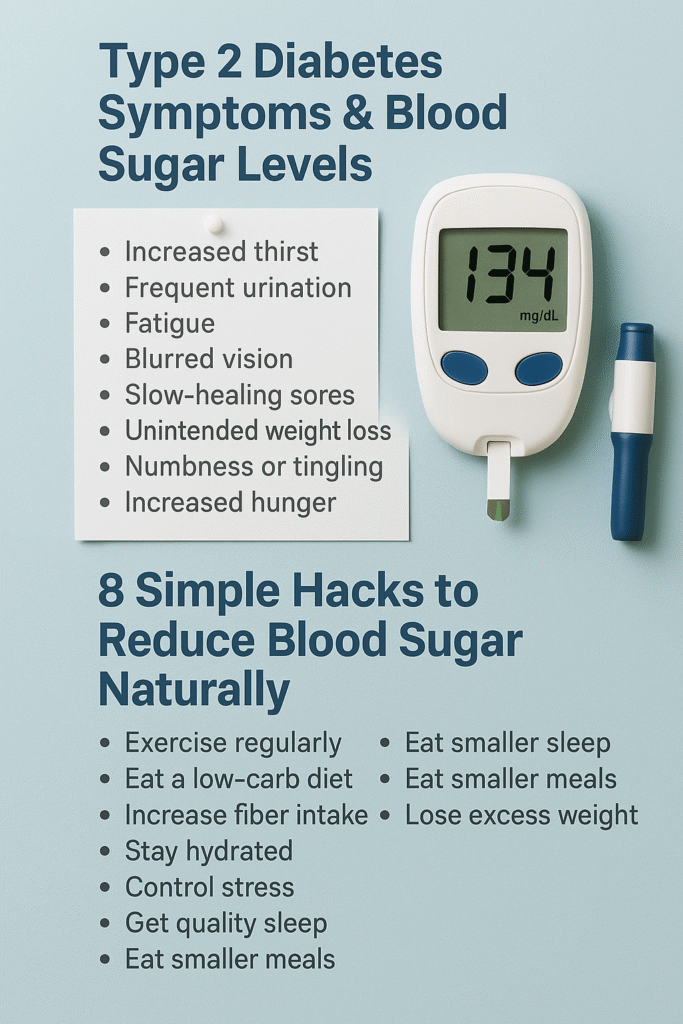Type 2 diabetes has quietly become a global health emergency—affecting over 537 million adults worldwide and costing economies billions each year. Left unchecked, the silent warning signs of Type 2 diabetes can lead to heart disease, kidney failure, nerve damage, and vision loss. But the good news is: with the right knowledge and simple, science-backed strategies, you can recognize Type 2 diabetes symptoms, understand type 2 diabetes blood sugar levels, and learn how to reduce blood sugar naturally—no drastic diets or extreme workouts required.
Whether you’re in the United States, the United Kingdom, or anywhere across the globe, this interactive, user-friendly guide arms you with the latest 2024–2025 data, practical hacks, tracking tools, and trusted resources—so you can take control of your health today.

Table of Contents
- Why Type 2 Diabetes Demands Your Attention
- Global, US & UK by the Numbers (2024)
- Type 2 Diabetes Symptoms: Don’t Ignore These Red Flags
- Understanding Healthy vs. High Blood Sugar Levels
- 8 Simple Hacks to Reduce Blood Sugar Naturally
- Interactive Daily Blood Sugar & Habit Tracker
- When to Seek Professional Help & Testing Options
- Additional Resources & TrenBuzz Link
- Disclaimer
1. Why Type 2 Diabetes Demands Your Attention
Type 2 diabetes develops when your body becomes resistant to insulin or doesn’t produce enough—causing elevated blood sugar that, over time, damages organs and nerves. Often, the condition progresses silently, with many people unaware of their risk until complications appear.
- High Stakes: Cardiovascular disease is the leading cause of death among people with diabetes.
- Rising Tide: Cases have more than tripled over the past 20 years, driven by sedentary lifestyles and poor dietary habits.
- Preventable & Manageable: Up to 90% of Type 2 diabetes cases could be prevented or delayed through lifestyle changes.
Recognizing early Type 2 diabetes symptoms and acting swiftly can mean the difference between a healthy life and lifelong health issues.
2. Global, US & UK by the Numbers (2024)
🌍 Global
- 537 million adults (20–79 years) living with diabetes; projected to reach 643 million by 2030 .
- 90–95% of these cases are Type 2 diabetes.
- Approximately 240 million remain undiagnosed.
🇺🇸 United States
- 38.4 million Americans (11.6% of the population) have diabetes; 8.7 million are undiagnosed .
- Diabetes-related costs: $412.9 billion annually (medical care, lost productivity).
- Higher prevalence in adults over age 45 and communities with limited access to healthy foods.
🇬🇧 United Kingdom
- 4.3 million people living with diabetes; 850 000 undiagnosed .
- 90% of diagnosed cases are Type 2.
- Annual NHS cost: £10 billion, accounting for 10% of its spending.
These figures underscore that Type 2 diabetes is neither rare nor trivial—it’s a public health priority requiring informed action.

3. Type 2 Diabetes Symptoms: Don’t Ignore These Red Flags
Because symptoms often develop gradually, it’s crucial to watch for two or more of the following:
- Excessive thirst & frequent urination: Kidneys flush out extra glucose via urine, leading to dehydration.
- Increased hunger despite eating: Cells starved of energy send hunger signals.
- Unexplained weight loss: Body breaks down fat and muscle for energy.
- Fatigue & brain fog: Glucose isn’t reaching cells efficiently.
- Blurred vision: High blood sugar pulls fluid from eye lenses, affecting focus.
- Numbness or tingling in hands/feet: Nerve damage (neuropathy).
- Slow-healing wounds & frequent infections: Elevated glucose impairs immune function.
- Darkened skin patches (acanthosis nigricans): Often found around neck or armpits, indicating insulin resistance.
Self-Check: If you notice these signs, schedule a blood sugar test—early intervention prevents complications.
4. Understanding Healthy vs. High Blood Sugar Levels
Monitoring your type 2 diabetes blood sugar levels is the cornerstone of management. Use this reference chart:
| Measurement | Normal Range | Prediabetes | Type 2 Diabetes |
|---|---|---|---|
| Fasting Plasma Glucose (FPG) | 70–99 mg/dL | 100–125 mg/dL | ≥ 126 mg/dL |
| 2-Hour Post-Meal (PPG) | < 140 mg/dL | 140–199 mg/dL | ≥ 200 mg/dL |
| HbA1c (Long-term average) | < 5.7% | 5.7–6.4% | ≥ 6.5% |
Pro Tip: Aim to test fasting and post-meal values at least weekly when newly diagnosed, then adjust frequency with stability.

5. 8 Simple Hacks to Reduce Blood Sugar Naturally
These strategies integrate seamlessly into daily life yet pack a powerful punch against hyperglycemia:
1. Move Within 30 Minutes After Eating
Even a 10-minute walk boosts insulin sensitivity and lowers post-meal spikes .
2. Prioritize Soluble Fiber
Add 15–20 g daily from oats, legumes, flaxseeds, and vegetables to slow glucose absorption.
3. Control Carb Portions with the Plate Method
– ½ plate non-starchy veggies
– ¼ plate lean protein
– ¼ plate whole grains or starchy veggies
4. Stay Hydrated with Water
Drinking water dilutes blood sugar and supports kidney function—skip sugary drinks and limit fruit juices.
5. Incorporate Apple Cider Vinegar (ACV)
2 tsp ACV in water before meals can reduce post-meal glucose by up to 20% .
6. Strength Training 2×/Week
Muscle tissue consumes more glucose than fat—even at rest. Focus on compound movements (squats, push-ups, rows).
7. Practice Intermittent Fasting (IF)
Time-restricted eating windows (e.g., 16:8) can improve insulin sensitivity—consult your doctor before starting.
8. Manage Stress & Sleep
Chronic stress and sleep deprivation raise cortisol, driving blood sugar up. Aim for 7–9 hours of quality sleep and daily stress relief (meditation, yoga).
Bonus Hack: Cinnamon supplement (1–2 g/day) may modestly lower fasting glucose—ask your healthcare provider.
6. Interactive Daily Blood Sugar & Habit Tracker
Track your progress to identify patterns and stay motivated. Print or screenshot this table:
| Date | Fasting (mg/dL) | Post-Meal (2 hr) | Walk After Meals? | Fiber (g) | ACV Taken? | Strength Training | Sleep (hrs) | Stress Level (1–10) |
|---|---|---|---|---|---|---|---|---|
| Aug 1 | 102 | 150 | Yes | 18 | Yes | No | 7.5 | 4 |
| Aug 2 | 95 | 130 | Yes | 22 | No | Yes | 8 | 3 |
Tip: Review weekly with your healthcare team or a registered dietitian to refine your approach.
7. When to Seek Professional Help & Testing Options
Testing Recommendations
- Annually if you’re over 45 or have risk factors (family history, overweight).
- At diagnosis, then every 3–6 months until stable.
Free & Low-Cost Testing
- United States:
- United Kingdom:
Professional Support
- Endocrinologists specialize in hormone and blood sugar disorders.
- Registered Dietitians (RDs) create tailored meal plans.
- Certified Diabetes Educators (CDEs) provide training on insulin, glucose monitoring, and lifestyle changes.
Note: Early referral to specialists reduces the risk of complications and improves long-term outcomes.
8. Additional Resources & TrenBuzz Link
- CDC – About Type 2 Diabetes (US):
https://www.cdc.gov/diabetes/basics/type2.html - NHS – Type 2 Diabetes Management (UK):
https://www.nhs.uk/conditions/type-2-diabetes/ - WHO – Diabetes Fact Sheet (Global):
https://www.who.int/news-room/fact-sheets/detail/diabetes - Diabetes UK – Know Your Risk & Care:
https://www.diabetes.org.uk/diabetes-the-basics/diabetes-symptoms - TrenBuzz – Managing Diabetes Naturally Guide:
Deadly Diabetes: Proven Diabetes Prevention Hacks to Tame Blood Sugar Spikes
9. Disclaimer
This blog post is for educational purposes only and does not replace professional medical advice, diagnosis, or treatment. Always consult your healthcare provider before making changes to your diet, exercise, or medication regimen. Information and external links are accurate at the time of publication but may change over time. All images used in this article are royalty‑free or licensed for commercial use and are provided here for illustrative purposes.
